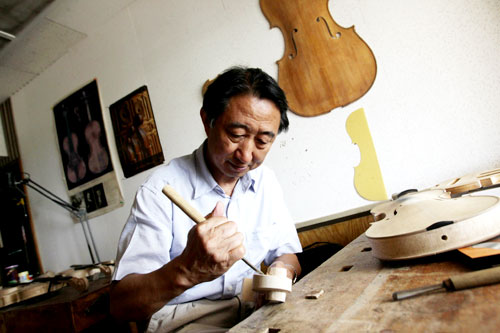
 |
|
Violin making master Zheng Quan works on an instrument at his home in Beijing. Jiang Dong / China Daily |
Acclaimed violin maker Zheng Quan has put China in the forefront of making top quality instruments. Zhu Linyong reports.
Zheng Quan believes a violin has life and soul, and says carving a violin is like giving birth to a baby. "When picking up a knife to carve a violin, I feel like I am putting all my heart into a labor of love," says the 62-year-old, an internationally renowned grandmaster of violin making.
"When the wood is in front of me, I want to finish the instrument as fast as I can, because I can already imagine the sound that will be created."
But it is a meticulous, time-consuming process. It may take him one year or more to find the wood he thinks will produce the right acoustic quality a violinist specifically requires.
A violin-making master can usually hand-make some 15 high quality violins a year. And the golden age for a master comes when he or she is around 70 years old.
Zheng makes just three to five violins a year and has carved about 100 violins for famed violinists from around the world.
"Maybe, it's because I take my work too seriously and I always believe I can do it better," says Zheng, who has been awarded more than 20 prizes at international violin-making competitions, including four gold medals.
Violin making is not just about technical competence. "It is a high art," Zheng says.
A decently made violin "reflects the violin maker's inner quality - upbringing, education, taste, emotions, and understanding of the character of the wood".
Violins were first brought to China in the 16th century by Italian Jesuit priests and violin making by local artisans began in China in the first decades of the 20th century, says Zheng, who heads the Chinese Violin Makers Association, which boasts more than 100 members from across the country.
"I never thought I would become a violin maker. Instead, my childhood dream was to become a virtuoso violin player," says Zheng, a native of Shanghai, where the first violin shops and violin maintenance studios sprouted in the early 1940s.